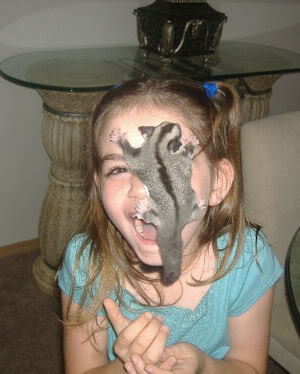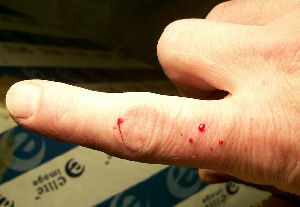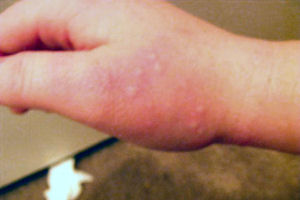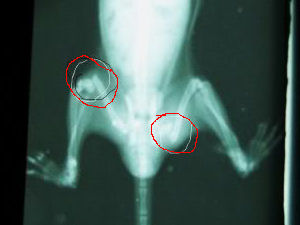|
|
 |
Christmas Sugar Glider
"I
think I'll get my kid a sugar glider for Christmas!" Many
people
find themselves contemplating buying a sugar glider for their child or
family. Many more simply happen upon these neat
little creatures while out with the
family at the mall and they blindly jump into
ownership of
this nifty exotic animal all based upon the impulse
buy. The purpose of this
article is to dissuade sugar gliders as a pet for children
or the average person and to at least minimally give you some
realities of ownership so that you can be properly informed
and begin the much needed task to learn more.
Impulse buy
There
are those out there who want you to be immediately charmed by these
neat little creatures such that you will fork over some major cash on
the spot. Beware of the things you are told by those who aim to make a
profit from you. Someone selling exotic animals at a kiosk, store,
fair, show, website are not in it for the benefit of the animal or for
you. Profit is always the name of the game and to
that
end most anything goes. Truths will be manipulated and you
will
most likely be lied to. Marketing magicians will
have you believe that their sugar gliders are better
than
others because they are hand raised when in fact they are really
shipped in by any number of mill-breeders that have been contracted to
do so. Marketing magicians will have you believe that their
pellet
food is the only way to go when in fact pellet food is generally a no
no with sugar gliders. Marketing magicians will cater to the impulse
buy and to children and will use graphics, pitches, mumbo-jumbo and
manufactured mental images for their products such as their cages
are better because they have "medical grade" coating. So watch
out
for the shyster.
A sugar glider is not a "pocket pet", it is an
undomesticated tree-dwelling wild animal that is a marsupial and has
very special needs. They are not simple to keep, feed or care for and
they do have a large list of health maladies that an owner must be
aware of.
You also do not need to pay some company $200+ for a
sugar glider and supplies. They can be had for much less if you take
the time to
look. A nearby "local" or "home" breeder is the best place to source
young animals and so many needing homes are listed on Craigslist, EbayClassifieds, Hoobly, Oodle, Petfinder
and many other websites. Most owners who get into
these creatures uninformed will soonafter realize how
difficult
they really are and will be looking for a way out. You can find
second-hand sugar gliders everywhere and they are just as good as fresh
young ones if not even better for various reasons.
Not for them
Are
snakes for kids? Are kangaroos for kids? Would you put
a squirrel in their pocket? Lions
tigers and bears are cute but they can hurt you and so can sugar
gliders. Sugar gliders bite. Biting is a very important way
that
sugar gliders experience their world. In the wild they will normally
constantly explore trees by biting into and removing bark looking for
bugs and larvae. In captivity, they explore you. The bottom jaw of a
sugar glider is made up of two long sharp teeth that can
easily
puncture human skin down to the bone and leave behind various forms of
bacteria in the process. Even tame sugar gliders will bite things to
test and explore and many a finger is easily mistaken for a treat. A
simple child's finger sticking into the cage can become a
major medical issue.
Sharing
your sugar gliders with other people is dangerous. Exotic or wild
animals are not a legally protected pet species, so if a guest in the
house were to get bitten, they have the absolute legal right to have
that animal put down for rabies testing and a doctor visit may
even force that that action.
You
cannot “grab” or squeeze a sugar glider to pick it up. They cling on to
everything and an actual grab could break nails, limbs and will most
certainly
result in a quick bite
from even the tamest of critters. Even a successful grabbing of a sugar
glider off your arm will result in long nail scrapes
on your
skin as it tries to resist your pulling.
Face hugs are dangerous. A leaping
glider can land on your face and inadvertently puncture your eye.
Children and unsuspecting guests will not be familiar with protecting
their face from a glider or know how to react to a potentially
dangerous situation.
Sharp nails do constantly puncture the top
layer of your skin and will inject various forms of bacteria in the
process leaving behind scrapes, wounds, scars, allergic
reactions and other possible medical issues. Even managed nails
will do this but keeping things taken care of does
reduce risks.
Sugar gliders are very agile and can easily escape
from adult hands, body
or pocket. They are also cage escape artists so extra care must be
taken to prevent this.
Not For You
We
all know that kids quickly loose interest in things and it may very
well be YOU feeding the complex diet at
10pm every night and working all of the other maintenance
needs.
Sugar gliders are smelly. Some control can be managed
through
diet, cleanliness and neutering, but cages certainly do get musky quick
no
matter what you do and most new owners just are not up to the task of
the needed daily maintenance. Sugar gliders are arboreal and always
cling to the cage walls or high up on a shelf or limb to pee. It can be
a mess.
Sugar gliders are extremely verbal and
noisy
creatures. They bark like a little dog in the middle of the night. They
hiss, fuss, rattle the cage and make noise on the exercise wheel all
night long and all of this can easily disturb a normal sleeper.
Sugar
gliders are colony animals and they absolutely need one of their own
kind to share a cage for mental stimulation. A minimum of two is
required or the solitary animal will stress and exist in a mental
disorder that can lead to overgrooming and eventually self mutilation. Human contact is
not a replacement for colony interaction.
Sugar gliders can suffer from a variety of health issues including calcium deficiency that leads to
brittle bones. They require health management, vet visits, cleanliness,
complex diet, large cage,
mental stimulation and many more things that you can learn about
online. To this day, most vets are not familiar
with treating sugar gliders due to their exotic nature and
small
numbers in captivity. You need to be aware of and familiar with the
various health issues that can happen over their 15 year life span.
Sugar
gliders can carry and transmit disease to humans although it is
probably rare. Unfortunately, with mass marketed, mill-bred,
shipped animals, you never know what you are getting and where it came
from. You can read more about this in the Zoonosis article. Skin reactions
are most common and there is history of serious allergic
reactions to sugar gliders as well as bacterial infections
from bites.
Sugar gliders do not get along with other pets and should never be
caged with or unsupervised while other pets are present.
Sugar gliders breed quickly so paying the vet to neuter is a highly
recommended practice and is common.
Summary
Sugar
gliders are not for children, they require more care and effort than
the salesman says, and if you are still reading this article, it is
obviously going to be YOUR pet to care for, so be informed,
keep
learning, and participate with others where you can. If you do your
own research, you will find lots of useful information from
people
who are not looking at your wallet: Sugar
bears and giardia
| Sugar
bears ending up dead | Shut Down Mall Kiosk | Dont Impulse Buy | Rough Gliding with Sugar Bears | Infected
finger bite | Sugar
glider bites hard | No
animal for children | How
to NOT handle your sugar glider
An impulse buy customer should at least understand
the large investment they are making on an animal that has very high
odds of dying before it reaches six months due to neglect by
an
uneducated and uninterested family. A
savvy and interested owner will fully understand the long term
commitment they are making when purchasing sugar gliders that can live
to be 15 years old.
Welcome!
This
article
was designed to raise some points to start you on the
quest for
learning and to introduce you to the community of owners and
information that is out there. You are welcome to visit the Sugar
Glider encyclopedia
and come read through, search and join in any of the forum
discussions. The sugar glider chatroom is often busy in the
evenings for real-time interaction with other owners.
Please read my other introductory articles: Sugar Glider Cages , My Sugar Glider Is Sick!
Life is full of questions, never be afraid
to ask them. Please never stop learning and always share what you learn
with others.
|









 |
|
|
**All content of SuggieSavers.orgŠ is
copywrite protected. Any and all use of content within
SuggieSavers.orgŠ, can only be used with written permission from
owners.**
|
|
|
 |

